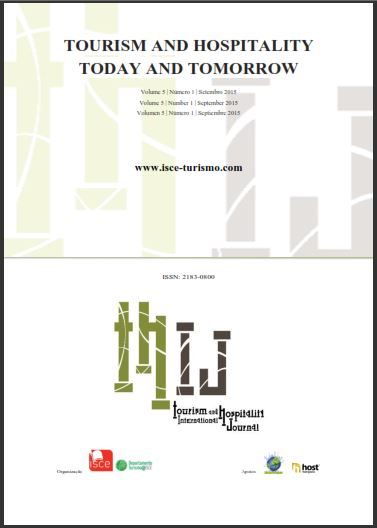A análise do turismo na Campânia como instrumento para o desenvolvimento de serviços culturais de qualidade para os turistas: O caso do "Reale Osservatorio Vesuviano
DOI:
https://doi.org/10.57883/thij5(1)2015.30297Abstract
The purpose of this work is to identify the guidelines for the development and diversification of the cultural touristic offer achievable at the Reale Osservatorio Vesuviano (ROV). Founded in 1841, it is the oldest volcano observatory in the world and it has always had the vocation for scientific-naturalistic and formative tourism. The present study investigates the connections between the sociology of tourism and the ROV’s sustainability and competitiveness as a tourist destination. Here it is performed a study of the tourist flow, based on the sociology of tourism and on the correct processing of data sets, distinguishing the ''statistical information on tourism" from "tourism statistics", as such a study is the basis of a proper market strategy in different sectors. Tourism remains, in fact, an important phenomenon in world economy: despite the economic crisis of recent years, international tourist arrivals show a positive development of the trend in all the major sub-areas into which the large international areas are traditionally divided. The principles for a future marketing plan were outlined after collecting all the relevant information. The plan was designed to enhance the overall touristic offer of the ROV, never ceasing to consider the integration of natural-scientific aspects and cultural events to be offered within the observatory itself.
References
Becheri, E., Migliaccio, M. (2008). I prodotti turistici in Campania. Il turismo termale. Ontit.it
Bencardino, F. (2010). Turismo e territorio. L'impatto economico e territoriale del turismo in Campania (p.368). Franco Angeli Ed..
Boccagna, P. (2010). Il turismo è un fenomeno spaziale. Trimestrale del Laboratorio “Territorio Mobilità e Ambiente – TeMALab”, 3(3), 21-34.
Bonacini, E. (2014). La realtà aumentata e le app culturali in Italia: storie da un matrimonio in mobilità. Il Capitale Culturale. Studies on the Value of Cultural Heritage, 9, 89-121. Università degli Studi di Macerata.
Buchner, G. (1984). Pithecusae nell’VIII sec. A.C.: crocevia del mondo antico. In Museo archeeologico di Pithecusae Isola d’Ischia. Istituto Poligrafico Zecca dello Stato.
Candela, G., Figini, P. (2003). Economia del turismo. McGraw-Hill Education per l’università.
De Lucia, M., Ottaiano, M., Limoncelli, B., Parlato, L. & Scala, O. (2010). Il museo dell’Osservatorio Vesuviano e il suo pubblico. Anni 2005-2009 – Rapporti Tecnici INGV.
Ente Nazionale Parco del Vesuvio (2014). Retrieved from http://www.vesuviopark.it/
EPT Napoli (2013). Bollettino di Statistica della Camera di Commercio di Napoli L’economia napoletana in cifre 2013.
ISTAT (2013a). Statistiche report.
ISTAT (2013b). Rapporto Annuale 2013 – La situazione del Paese.
ISTAT (2010a). Annuari di Statistica 2010 “Movimento dei clienti negli esercizi alberghieri”.
ISTAT (2011). Annuari di Statistica 2011 “Movimento dei clienti negli esercizi alberghieri”.
ISTAT (2012). Annuari di Statistica 2012 “Movimento dei clienti negli esercizi alberghieri”.
ISTAT (2013c). Annuari di Statistica 2013 “Movimento dei clienti negli esercizi alberghieri”.
ISTAT (2008). Capacità e movimento degli esercizi recettivi.
ISTAT (2009). Capacità e movimento degli esercizi recettivi.
ISTAT (2010b). Capacità e movimento degli esercizi recettivi.
Mattera, M. (2011). Il vulcano Ischia – Miti, storia, scienza. Ed. IMAGAENARIA, Italy.
Ministero dei Beni Ambientali e Culturali – MIBAC (2014). Retrieved from http://www.beniculturali.it
OECD (2011). Persistence of high unemployement: What risks? What policies? Economic Outlook, 89, OECD Publishing.
Osservatorio Nazionale del Turismo (2013). Customer care turisti, rapporto annuale. Istituto Nazionale Ricerche Turistiche.
Pechlaner, H.,Weiermair, K. (2000). Fondamenti di marketing e gestione delle destinazioni turistiche. TUP, Milano.
Pencarelli, T., Forlani, F. (2002). Il marketing dei distretti turistici. Sistemi vitali nell’economia delle esperienze. Sinergie, n.58, CUEIM, Verona.
Rifkin, J. (2000). The age of access (p.405). Mondadori, Milano: Saggi.
Russo, M., Antolini, F. (2013). Sostenibilità e misura della pressione turistica. In M. A. La Torre, A. Sangianantoni, G. Avvisati, E. Marotta, M. Ghilardi, G. De Natale, P. Guidace, & S. Tulino (Eds.) (2014), Dal turismo sostenibile alla responsabilità sociale d'impresa. Il contesto legale e socio-economico per la commercializzazione delle attività museali della sede storica della Sezione di Napolli, INGV “Osservatorio Vesuviano”. Rapporti Tecnici n. 282.
Savelli, A. (2014). Sociologia del turismo (p.384). Franco Angeli Ed..
SHIFT (2009). Sustainable tourism in fragile territories – Joint analysis and stakeholder toolkit.
Soprintendenza Speciale Beni Archeologici di Pompei, Ercolano e Stabia 2013 Retrieved from http://www.pompeiisites.org/
Trimarchi, E. (2013). Museo Osservatorio Vesuviano “Analisi e statistiche affluenza visitatori” anno 2012 e confronto anni 2009-2012. Rapporto interno Osservatorio Vesuviano – INGV.
UNWTO (2013a). Tourism Highlights.
UNWTO (2013b). Tourism Towards 2030.
UNWTO (2013c). World Tourism Barometer 2013.
UNWTO (2013d). XVIII Rapporto sul Turismo Italiano.
Downloads
Published
How to Cite
Issue
Section
License
Copyright (c) 2023 This work is licensed under a Creative Commons - Attribution 4.0 International (CC BY 4.0)

This work is licensed under a Creative Commons Attribution 4.0 International License.
This work is published under the Creative Commons Attribution 4.0 International License.






